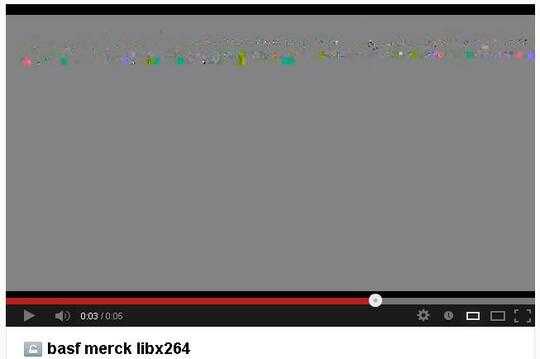13
18
I have a sequence of PNGs (here is one specimen) which I turn into a video with ffmpeg:
ffmpeg -r 10 -i image%03d.png -s 1380x720 -c:v libx264 -qscale 10 -r 30
basf_merck_libx264.mp4
With VLC it looks all nice and dandy but on youtube all I see is gray!? why?

After a while a horizontal bar with colorful spots is shown:

When I add '-pix_fmt yuv420p' to the command then youtube shows the clip correctly. But then the highest quality I can choose is 480p which is to low for this purpose.
ffmpeg output
C:\Users\Raffael\Documents\proj>ffmpeg -r 10 -i image%03d.png -s 1380x720 -c:v libx264 -qscale 10 -r 30 basf_merck_libx264.mp4
ffmpeg version N-48785-g2ea3f37 Copyright (c) 2000-2013 the FFmpeg developers
built on Jan 12 2013 20:45:33 with gcc 4.7.2 (GCC)
configuration: --enable-gpl --enable-version3 --disable-w32threads --enable-avisynth --enable-bzlib --enable-fontconfig --enable-frei0r --enable-gnu
tls --enable-libass --enable-libbluray --enable-libcaca --enable-libfreetype --enable-libgsm --enable-libmp3lame --enable-libopencore-amrnb --enable-l
ibopencore-amrwb --enable-libopenjpeg --enable-libopus --enable-librtmp --enable-libschroedinger --enable-libspeex --enable-libtheora --enable-libtwol
ame --enable-libvo-aacenc --enable-libvo-amrwbenc --enable-libvorbis --enable-libvpx --enable-libx264 --enable-libxavs --enable-libxvid --enable-zlib
--enable-filter=frei0r
libavutil 52. 14.100 / 52. 14.100
libavcodec 54. 86.100 / 54. 86.100
libavformat 54. 59.107 / 54. 59.107
libavdevice 54. 3.102 / 54. 3.102
libavfilter 3. 32.100 / 3. 32.100
libswscale 2. 1.103 / 2. 1.103
libswresample 0. 17.102 / 0. 17.102
libpostproc 52. 2.100 / 52. 2.100
Input #0, image2, from 'image%03d.png':
Duration: 00:00:02.04, start: 0.000000, bitrate: N/A
Stream #0:0: Video: png, rgb24, 1380x720, 25 fps, 25 tbr, 25 tbn, 25 tbc
Please use -q:a or -q:v, -qscale is ambiguous
File 'basf_merck_libx264.mp4' already exists. Overwrite ? [y/N] y
using cpu capabilities: MMX2 SSE2Fast SSSE3 FastShuffle Cache64
[libx264 @ 00000000021c6fe0] profile High 4:4:4 Predictive, level 3.2, 4:4:4 8-bit
[libx264 @ 00000000021c6fe0] 264 - core 129 r2230 1cffe9f - H.264/MPEG-4 AVC codec - Copyleft 2003-2012 - http://www.videolan.org/x264.html - options:
cabac=1 ref=3 deblock=1:0:0 analyse=0x3:0x113 me=hex subme=7 psy=1 psy_rd=1.00:0.00 mixed_ref=1 me_range=16 chroma_me=1 trellis=1 8x8dct=1 cqm=0 dead
zone=21,11 fast_pskip=1 chroma_qp_offset=4 threads=3 lookahead_threads=1 sliced_threads=0 nr=0 decimate=1 interlaced=0 bluray_compat=0 constrained_int
ra=0 bframes=3 b_pyramid=2 b_adapt=1 b_bias=0 direct=1 weightb=1 open_gop=0 weightp=2 keyint=250 keyint_min=25 scenecut=40 intra_refresh=0 rc_lookahea
d=40 rc=crf mbtree=1 crf=23.0 qcomp=0.60 qpmin=0 qpmax=69 qpstep=4 ip_ratio=1.40 aq=1:1.00
Output #0, mp4, to 'basf_merck_libx264.mp4':
Metadata:
encoder : Lavf54.59.107
Stream #0:0: Video: h264 ([33][0][0][0] / 0x0021), yuv444p, 1380x720, q=-1--1, 15360 tbn, 30 tbc
Stream mapping:
Stream #0:0 -> #0:0 (png -> libx264)
Press [q] to stop, [?] for help
frame= 151 fps= 16 q=-1.0 Lsize= 1995kB time=00:00:04.96 bitrate=3290.5kbits/s dup=100 drop=0
video:1992kB audio:0kB subtitle:0 global headers:0kB muxing overhead 0.127092%
[libx264 @ 00000000021c6fe0] frame I:1 Avg QP:22.19 size: 57949
[libx264 @ 00000000021c6fe0] frame P:54 Avg QP:26.90 size: 36277
[libx264 @ 00000000021c6fe0] frame B:96 Avg QP:21.56 size: 236
[libx264 @ 00000000021c6fe0] consecutive B-frames: 5.3% 1.3% 85.4% 7.9%
[libx264 @ 00000000021c6fe0] mb I I16..4: 71.1% 2.5% 26.4%
[libx264 @ 00000000021c6fe0] mb P I16..4: 0.6% 0.5% 5.7% P16..4: 3.1% 2.1% 2.9% 0.0% 0.0% skip:85.0%
[libx264 @ 00000000021c6fe0] mb B I16..4: 0.2% 0.1% 0.0% B16..8: 4.7% 0.1% 0.0% direct: 0.0% skip:94.9% L0:77.6% L1:22.3% BI: 0.1%
[libx264 @ 00000000021c6fe0] 8x8 transform intra:7.7% inter:5.2%
[libx264 @ 00000000021c6fe0] coded y,u,v intra: 59.5% 54.3% 52.9% inter: 1.3% 1.0% 0.6%
[libx264 @ 00000000021c6fe0] i16 v,h,dc,p: 81% 15% 4% 0%
[libx264 @ 00000000021c6fe0] i8 v,h,dc,ddl,ddr,vr,hd,vl,hu: 10% 5% 64% 3% 2% 4% 3% 4% 3%
[libx264 @ 00000000021c6fe0] i4 v,h,dc,ddl,ddr,vr,hd,vl,hu: 27% 13% 21% 7% 6% 7% 6% 7% 6%
[libx264 @ 00000000021c6fe0] Weighted P-Frames: Y:0.0% UV:0.0%
[libx264 @ 00000000021c6fe0] ref P L0: 65.3% 9.0% 20.2% 5.5%
[libx264 @ 00000000021c6fe0] ref B L0: 73.0% 21.7% 5.3%
[libx264 @ 00000000021c6fe0] ref B L1: 90.8% 9.2%
[libx264 @ 00000000021c6fe0] kb/s:3241.64
I collected the information on my web-site: http://www.joyofdata.de/blog/hd-clips-with-ffmpeg-for-youtube-and-vimeo/
Please supply the full, uncut console output for the FFmpeg command(s). Pixel formats aren't related to the dimensions, so you should always be able to select more than 480p resolution on YouTube if your source is 720p and above. – slhck – 2013-01-13T22:06:41.687
added the output of the ffmpeg command. The clip watched with VLC still shows the old larger resolution. But youtube offers me just 480p. – Raffael – 2013-01-13T22:12:52.803